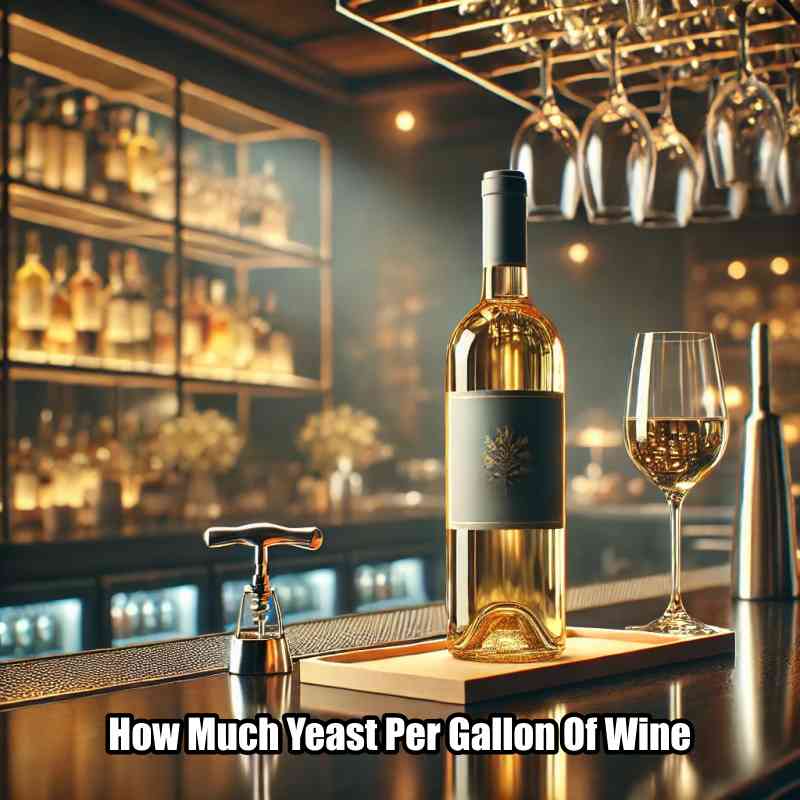Making wine at home is a rewarding experience, but getting the right amount of yeast is key to perfecting your brew.
So, how much yeast per gallon of wine? This question is crucial for ensuring a smooth fermentation process and achieving the desired flavors.
In this blog post, we’ll break down the general guidelines for yeast quantities, tailored to different wine types and specific yeast strains.
Whether you’re crafting a robust red or a delicate white, we’ll help you get the yeast just right. Let’s dive in and make your next batch of wine a success!
How Much Yeast Per Gallon Of Wine
The general guideline for adding yeast to your wine is approximately 1 gram per gallon. However, this measurement can vary depending on the type of wine and the specific yeast strain you are using.
For instance:
- Full-bodied Red Wines (e.g., Merlot): These wines may benefit from slightly more yeast, around 1.5 grams per gallon. The increased yeast helps manage the higher sugar content and ensures a robust fermentation process.
- Delicate White Wines: These require precise yeast measurements to avoid off-flavors. Stick closely to the 1 gram per gallon rule to maintain the wine’s delicate flavor profile.
It’s essential to adjust the amount of yeast based on the specific characteristics of your wine and the yeast strain.
What Factors Affect the Amount of Yeast Needed?
Several factors can influence the amount of yeast required for your wine:
- Sugar Content: Higher sugar levels may require more yeast for effective fermentation.
- Yeast Strain: Different strains have varying alcohol tolerances and efficiency.
- Fermentation Speed: A faster fermentation might need more yeast, but it can risk creating unwanted flavors.
- Nutrient Availability: Proper nutrients help yeast thrive; lacking them might necessitate additional yeast.
- Temperature: Optimal temperatures ensure healthy yeast activity and efficient fermentation.
Can You Use Too Much Yeast?
Yes, using too much yeast can lead to over-fermentation, resulting in off-flavors and an imbalance in your wine’s profile.
Overcrowded yeast can produce excessive esters and higher alcohol content, potentially spoiling the desired taste and aroma of your wine.
It’s essential to adhere to recommended quantities and adjust based on personal preferences and experiences.
How Do You Rehydrate Yeast Properly?
Rehydrating yeast before adding it to your must (unfermented grape juice) is crucial for effective fermentation. Here’s a simple process:
- Use warm water (95-105°F or 35-40°C) to rehydrate the yeast.
- Allow the yeast to sit in the water for about 15-20 minutes.
- Stir gently to ensure even distribution.
- Add the rehydrated yeast to your must.
This process helps the yeast cells absorb nutrients and start fermenting more efficiently.
What Happens If You Pitch Too Much Yeast?
Pitching too much yeast can cause several issues:
- Off-Flavors: Increased ester production can result in undesirable tastes.
- Over-Fermentation: Rapid fermentation might lead to a dry, overly alcoholic wine.
- Stuck Fermentation: Overcrowded yeast competes for resources, potentially stalling the process.
FAQs
1. How many packets of yeast do I need for 6 gallons of wine?
Typically, one packet of yeast is sufficient for up to 5 gallons of wine. For 6 gallons, you would need at least two packets.
2. How much yeast do I need for 1 gallon?
Generally, 1 gram of yeast per gallon of wine is recommended, but this can vary based on specific strains and recipes.
3. Can you double yeast in wine making?
Yes, doubling yeast can add complexity and increase alcohol content. However, it’s crucial to adjust water and sugar levels accordingly.
4. How do you know when wine fermentation is complete?
Fermentation is typically complete when the airlock stops releasing CO2 bubbles and hydrometer readings remain constant over several days.
5. How do you ensure wine yeast is working?
Signs of active yeast include bubbles on the liquid surface, changes in aroma, and a decrease in sugar gravity as measured by a hydrometer.
Conclusion
In summary, determining how much yeast per gallon of wine is essential for successful fermentation and achieving your desired flavor profile.
Generally, 1 gram of yeast per gallon is a good starting point, with slight adjustments for different wine types and yeast strains.
Full-bodied reds might need up to 1.5 grams per gallon, while delicate whites require precise measurements.
Remember to rehydrate yeast properly and consider factors like sugar content, temperature, and nutrient availability for optimal results.
With these guidelines, you can confidently craft delicious homemade wine. Cheers to your winemaking success!

